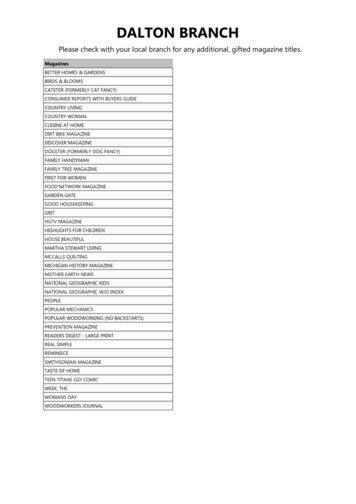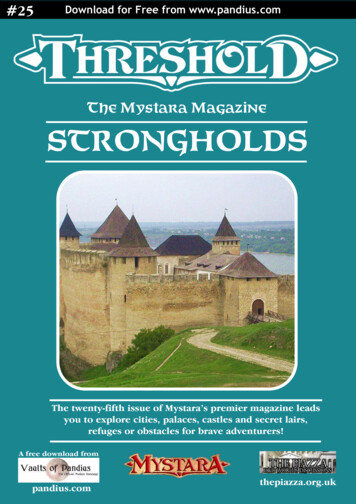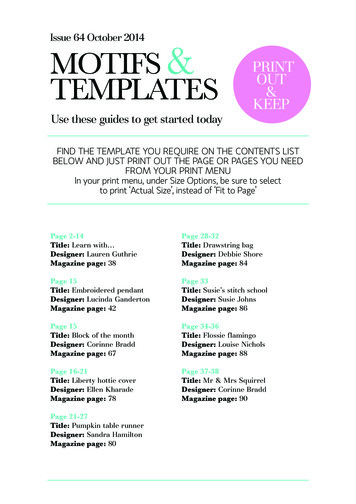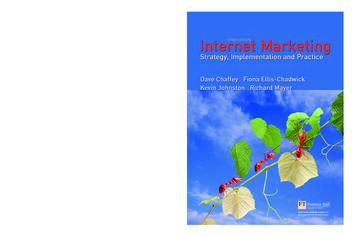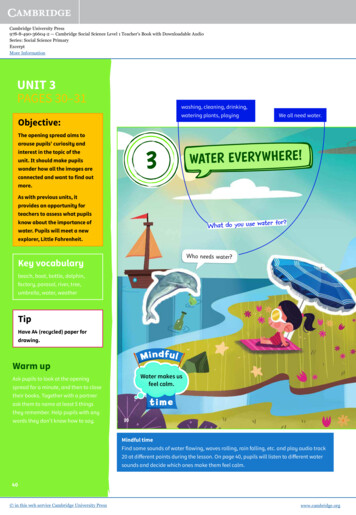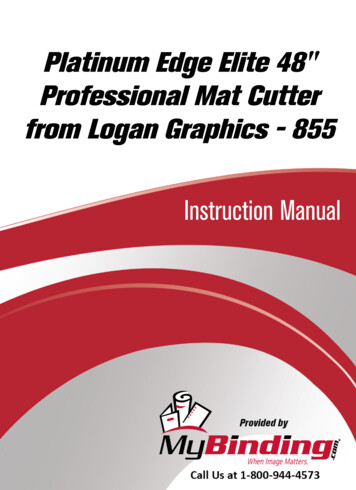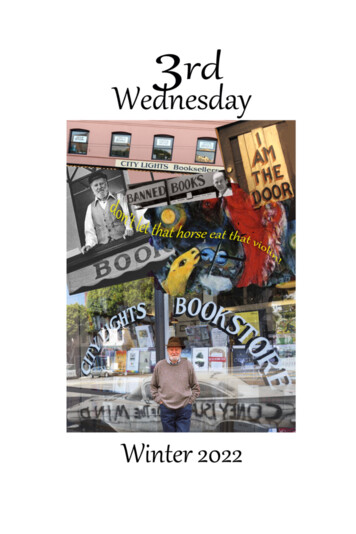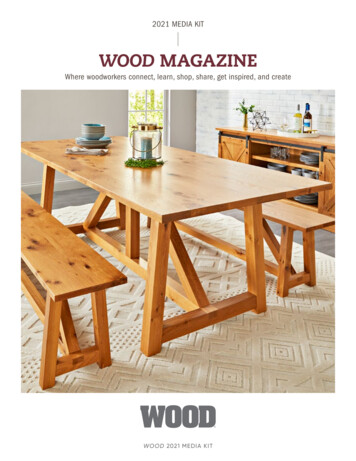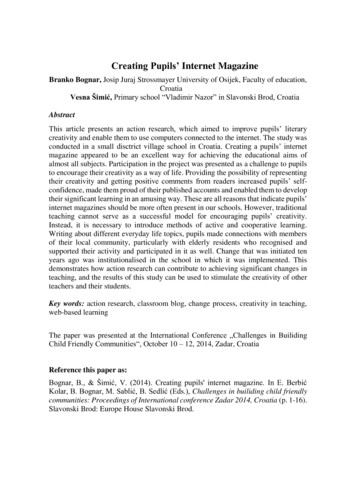
Transcription
Creating Pupils’ Internet MagazineBranko Bognar, Josip Juraj Strossmayer University of Osijek, Faculty of education,CroatiaVesna Šimić, Primary school “Vladimir Nazor” in Slavonski Brod, CroatiaAbstractThis article presents an action research, which aimed to improve pupils’ literarycreativity and enable them to use computers connected to the internet. The study wasconducted in a small disctrict village school in Croatia. Creating a pupils’ internetmagazine appeared to be an excellent way for achieving the educational aims ofalmost all subjects. Participation in the project was presented as a challenge to pupilsto encourage their creativity as a way of life. Providing the possibility of representingtheir creativity and getting positive comments from readers increased pupils’ selfconfidence, made them proud of their published accounts and enabled them to developtheir significant learning in an amusing way. These are all reasons that indicate pupils’internet magazines should be more often present in our schools. However, traditionalteaching cannot serve as a successful model for encouraging pupils’ creativity.Instead, it is necessary to introduce methods of active and cooperative learning.Writing about different everyday life topics, pupils made connections with membersof their local community, particularly with elderly residents who recognised andsupported their activity and participated in it as well. Change that was initiated tenyears ago was institutionalised in the school in which it was implemented. Thisdemonstrates how action research can contribute to achieving significant changes inteaching, and the results of this study can be used to stimulate the creativity of otherteachers and their students.Key words: action research, classroom blog, change process, creativity in teaching,web-based learningThe paper was presented at the International Conference „Challenges in BuilidingChild Friendly Communities“, October 10 – 12, 2014, Zadar, CroatiaReference this paper as:Bognar, B., & Šimić, V. (2014). Creating pupils' internet magazine. In E. BerbićKolar, B. Bognar, M. Sablić, B. Sedlić (Eds.), Challenges in builiding child friendlycommunities: Proceedings of International conference Zadar 2014, Croatia (p. 1-16).Slavonski Brod: Europe House Slavonski Brod.
1. INTRODUCTIONWhen the French teacher Célestin Freinet introduced students' magazines printed on thesimple printing machine at the beginning of the last century, he could not begin to imagine thatstudents’ magazines could be created and distributed using the sophisticated devices whichhave subsequently become available, such as computers and the internet. Althoughcontemporary technical capabilities are far bigger, the main idea stayed the same – to givestudents the freedom to express themselves through text in a way that surpasses plain writingexercises and develops into literary creations of their thoughts and feelings. That is why thosewords written by Freinet in 1927 still sound like the ideal to be achieved in contemporaryschools:“The dream of all the modem educators who are looking for a rational education is tomake the life of a child and the life of the village the center of the life in the classroom. Thenecessity to teach reading from textbooks conceived, written, and printed by adults cannot beimplemented to meet the needs of our students and their milieu. But if we have a printingdevice that would allow us to print what interests us, and if our students can put down on apage their thoughts, their feelings and narratives they wrote, then these pages become thecenterpiece of their schoolwork.” (Freinet, as cited in Acker, 2007, p. 53)Computers and mobile devices connected to the internet are now easily accessible andhave become an inseparable part of the modern way of living, especially for young peopleusing them in various ways. Sadly, most of our schools do not use these multimedia devicesfor educational purpose, and, furthermore, forbid their use in school in general 1 . This resultsin children and young people being left to themselves in a very complex, but also veryappealing, communicational space. Young people have a great freedom to express themselvesusing the new media. However, without the participation of the older generations – the digitalnewcomers2 , the media space is often filled with superficial, infantile and even vulgarcontents. In the eyes of the new generations, the school, due to its inertia and rigidness, hasless and less meaning and becomes, for these young generations, a place where they learnabout things that have almost no connection with the needs and lives of people in the modernsociety.The school should, instead of the current praxis, recognise the educational possibilities ofthe new information-communication technologies. Teachers should use them more to enablelearning that is not reduced to the mere transfer of knowledge, but give the students thepossibility to participate in many joint activities with their peers and adults, because thelearning process happens in relations to other people (McDermott, 1999, p. 16) and activitiesthat are a part of everyday life (Smith, 1999). It is important that children and young peoplelearn to express themselves clearly with words, and thus emancipate their human capabilities,which at the same time presents the goal of education:“Namely, if education is development of human essential strengths, their human powers,and it is, then it is above all development of their creative powers, through which peopleestablish themselves as free beings, as beings relying completely on themselves, as beingsbelonging to utterly themselves, and that is their essence as humans. Education is, therefore,activity which develops human strengths according to their maximum abilities, and that meansthat the way towards something possibly different stays continuously open.” (Polić, 1993, p.21-22).1That refers to using mobile phones in the classroom.Prensky (2001) thinks that all those born before the general digitalisation of the everyday life, i.e. before the internet,find it difficult to adapt to the new surrounding. It is a very serious problem, especially for education because ourDigital Immigrant instructors, who speak an outdated language (that of the pre-digital age), are struggling to teach apopulation that speaks an entirely new language“ (p. 2)22
2. RESEARCH METHODOLOGYSince this study is focused on improving existing practice, we chose action research asthe most appropriate research design. Namely, “action research provides a means for teachersor educators in the schools to improve their practices of taking action and to do so byparticipating in research” (Creswell, 2011, p. 577).Carr and Kemmis (2004) distinguish technical, practical and emancipatory actionresearch. Unlike technical action research, in which the control over the research is not in thehands of the practitioner, and practical action research, in which the accent is put on betterunderstanding of practice, critical-emancipatory action research tends to create basic changesthat influence social formations in which the practice is conducted:“Thinking of these social formations as ( ) practice architectures allows us to think ofthem as made by people, and thus as open to be re-made by people. People involved in criticalaction research aim to change their social world collectively, by thinking about it differently,acting differently, and relating to one another differently—by constructing other practicearchitectures to enable and constrain their practice in ways that are more rational (in the senseof reasonable), more productive and sustainable, and more just and inclusive.” (Kemmis,McTaggart, Nixon, 2014, p. 14)In our case, the intention was to emancipate the creative potential of all participants in thecase study, especially of the students, and to change the routine way of the educational practice.Teachers and the students were actively included in “designing and implementing the changes,so it becomes participatory and more democratic, and hence socially critical” action research(Tripp, 2005, p. 456).This action research is also created as the case study. Case study represents systematicresearch focusing on individual cases. Cases can be individuals, programmes, institutions orgroups, even whole states. Data gathered on each case can be versatile: interviews,observations, documentation, statistic ratios, impressions and opinions of others about thecase, personal logs and other. Although more teachers were involved in realisation of the ideaabout the students’ internet magazine, this study describes only one of these cases. In so doing,we tried to cover all features of a case study: “It is concerned with a rich and vivid description of events relevant to the case. It provides a chronological narrative of events relevant to the case. It blends a description of events with the analysis of them. It focuses on individual actors or groups of actors, and seeks to understand theirperceptions of events. It highlights specific events that are relevant to the case. The researcher is integrally involved in the case. An attempt is made to portray the richness of the case in writing up the report.”(Hitchcook & Hughes, 1995, as cited in Cohen, Manion and Morrison, 2005, p. 182)Taking into consideration that we conducted this research with children, we asked for andgathered written permissions of their parents to videotape, photograph and publish thematerials in scientific and professional publications. We tried to avoid publishing students’names, but since they undersigned the published literary works in the magazine, which waspublished on the internet, it was impossible but also unnecessary to preserve their completeanonymity. The ombudsman for children interpreted the law, which says that “filming childrenwith the aim of promoting the work of a kindergarten or a school and children activities in thepositive contest, generally should not harm the child, but the parents should be given a chanceto declare whether they give their consent.” Our case included positive children activities thatmade both them and their parents proud.3
3. CONTEXT AND RESEARCH PROBLEMThis action research was conducted in a small district village school in Klakar, part ofPrimary school “Vladimir Nazor,” Slavonski Brod. During the time of the research (Januaryuntil end May, 2006) classes were organised in a combined four-class group of 12 students,held by the schoolteacher Vesna Šimić. Branko Bognar, at the time of the research, was theschool pedagogue and later became assistant on Faculty for Humanities and Social Sciencesin Osijek.During the time Branko was a pedagogue, he started a learning community in which wediscussed various professional issues such are cooperative learning, communication in theclassroom, creativity inside the class and similar. At the beginning, a few other teachers fromother schools joined this learning community, and some even started such a community in theirschools. Using a virtual space for cooperation3 (http://mzu.sbnet.hr/) put at our disposal wedesigned and started a project “Network of Learning Communities”. The main aim of theproject was professional cooperation and exchange of experience between members oflearning communities from different schools, some of which were situated in other cities.In the learning community in our school we learned about technical possibilities of theblog system, which we decided to use for publishing students’ magazines, and we held multipleworkshops about class organization, which encourages students’ literary and art creation.Vesna Šimić, a schoolteacher, was also actively included in the learning community activitiesand had the conditions for creating a students’ internet magazine in her district school inKlakar. That school had only the morning shift classes, and the classroom was furnishedaccording to the needs and ideas of the students and their parents. This classroom was the otherhome for the students. They could use various educational tools, most importantly the newcomputer that was in constant use. Beside the computer, they could also use the colour printer,for which they often had to buy cartridges and paper themselves. They also had at their disposala CD player and TV with video recorder. Other equipment and materials were also obtainedby the students and the teacher This made a rich collection of educational materials (colourchalks, buttons, small stones, shells, seeds, threads, wool threads, sticks, books, newspapersand so on) that students could play with and use for creative work. The classroom, which wasnewly renovated, had large windows that were used for displaying students’ works and nicecurtains chosen and decorated by the teacher Vesna and her students. Cleaning of thatclassroom was also one of the responsibilities the students willingly took on, which gave thecleaner a pleasant surprise.The school is situated in a restful plain village Klakar in Posavina, 14 km away fromSlavonski Brod. The school building goes back to the time of Slavonian Military Frontier whenit was used for military purposes. It has been used as a school since 1880. During theimplementation of the project, the school façade was decrepit and only the roof of the buildingwas newly renovated. Inside the school building there is one other classroom, the hall, toiletsand a two-bedroom apartment for the schoolteacher. Around the building there is a yard, whosespring and summer blossoms and smells invite students and many of the passer-byes to activelyspend their time in it or just to relax in the shades of the hundreds of years old walnut and peartrees (http://youtu.be/YL9ecq77-D8). The students, the teacher, the janitor and the cleaner domaintenance of the yard.Values that we tried to create in our praxis are freedom, creativity, cooperation andentertainment. Freedom means the students’ choice to decide on and participate in deciding3It is CMS (content management system) and e-learning system whose author is Željko Klindžić, computerprogrammer from Slavonski Brod. Later on we used Moodle – „a learning platform designed to provide educators,administrators and learners with a single robust, secure and integrated system to create personalised learningenvironments“ (https://docs.moodle.org/27/en/About Moodle).4
about important aspects of educational process. Only free students can be highly motivated forachieving quality in what they are doing (Glasser, 2004).Plucker and Makel (2010) think that creativity “is the interaction among aptitude, process,and environment by which an individual or group produces a perceptible product that is bothnovel and useful as defined within a social context” (p. 49). However, usefulness or adequacyin children’s creativity cannot be evaluated in the same way as the creativity of adults:“We can consider children’s efforts appropriate if they are meaningful, purposeful, orcommunicative in some way. If students successfully communicate an idea or endeavour tosolve a problem, their efforts can be considered appropriate. If they do so in a way that isoriginal, at least to them, we can consider the efforts creative.” (Starko, 2010, p. 8)Cooperation is the organisation of the classes in various sociological forms thatcontribute to the learning in the wider sense of the word. It includes development of socialskills that are a part of the group of important competences of a modern human being (Klippert,2001).We also think that learning should be saturated with humour (Matijević, 1994), conductedin the relaxed class atmosphere and in a fun way (Dryden and Vos, 2001). Only in thoseconditions are students capable of expressing themselves and developing their creativepotentials.Despite the awareness of the importance of these values, they were not always fulfilledfully. Creativity of the teacher sometimes dominated the students’ creativity. In addition,Branko’s “optimistic” expectations from the students and the teachers were soon exceeded bytheir creative ideas and performances. The biggest problem at the beginning was Vesna’s lackof trust in her abilities and those of her students. She thought that she and her students hadinsufficient knowledge for editing a students’ internet magazine. Branko encouraged her bytelling that editing an internet magazine is not so difficult and that it would be a learningprocess for all of us in the realization of that idea.In order to realise her values, Vesna tried to provide her students with different ways ofdeveloping their literary and art creations (http://youtu.be/d-vSsF4k7hw), some of which wereincluded in the class magazine called “Klik-klak.” At the beginning, students wrote thismagazine by hand and later on the computer and then they printed materials and bound themon a bookbinding machine. Although these magazines enabled students to publish their literaryand art creations, the students and their teacher faced a number of technical difficulties. Dueto the lack of financial means, they published a very small number, namely only two copies oftheir magazine. Students had to supply paper and cartridges for the printer themselves. Only asmall number of people could read their magazine as students borrowed them and took themhome for their parents and friends to read. After the donation of new computers with internetconnection, “Klik-klak” has been published on the internet. Hereby started our new actionresearch in which we wanted to improve students’ literary creation and teach students how touse computers and the internet.4. ACTION RESEARCH PLANDuring the school year 2004/2005, the activities of creative writing and publishingmaterials on the class blog were conducted spontaneously and without planning, supervisionand evaluation of the results. In the second semester of the school year, 2005/2006 editing thestudents’ internet magazine was included in the project “Network of Learning Communities”and grew to be an action research. The important step was making the plan that, according toour wish, had to include students’ ideas. Their ideas were gathered during the homeroom class,and in the art class. They expressed their ideas through art works5
Figure 1. Students illustrate the action research planSome of the students’ proposals were:I. G., 1. c.: “I would like to take pictures with my camera! I took your pictures at [thepond] Bebrinka, so I know how to do it.”I. B., 2.c: “It would be good if everyone would write, not only the older students.”I. S., 2. c.: “We could draw unusual characters and write only using our imagination,about something that is not real.”I. S., 3.c.: “How about writing a funny weather forecast, on Monday and Friday?”M. B., 3.c.: “We could write about animals, we haven’t done it till now.”S. A., 3. c.: “We could write about the past times, old customs and games.”F. G., 4.c.: “Let us make it funnier, it is so serious now.”I. M., 4.c.: “How about finding something in that book on history of our school?”(Students from Klakar, personal communication, January 16, 2006)Acknowledging students’ ideas we agreed to try to achieve four main goals: improvementof children’s literary creation; training of students and the teacher to use a computer;preserving local domestic culture and especially the blog system and; the satisfaction of thestudents in participating in those activities (Table 1). We intended to: use creative writingmethods; research local customs, costumes, games, toys, folk songs, tools, trades, ways ofliving, all done by talking to the local people; read and gather old books, items, and thenwriting texts in WORD programme; take photos and do graphic processing on the computer;use the internet browser, E-mail and other curricular and extracurricular activities of thestudents.We gathered data from published articles and readers’ comments in the students’magazine , E-mails with comments fromprofessionals, interviews with professionals, local people and students, video recordings of thestudents’ activities, photo collections, audio recordings, research diaries and comments ofcritical friends put on the web forum.6
Table 1. Goals and criteria for evaluation of successGoalsCriteriaImprovementof More inclusion of the students in literary work for publishing onchildren’sliterary the BLOG. Positive review of professionals and positive readers’comments.creationTraining of students Students can write MS Word document, process a photo inand the teacher to use graphic programme, copy and paste text in BLOG editorial, writeand publish articles on BLOG and on forums, use interneta computerbrowser, write and send E-mails.Preservinglocal Students show interest in learning about the local culture, they canname and understand the use of items from the past, they revivedomestic cultureold games, communicate with the elderly villagers.Satisfaction of the Students express their content in the evaluation papers.studentsin Video recordings and photographs show the satisfaction of theparticipatingin students with their participation in the activities (e.g. smiles ontheir faces).planned activitiesIn action research, critical friends play an important role. A critical friend is mostly aperson who shares the professional context and helps the practitioner in the implementation ofthe action research by advising him/her and giving feedback information (McNiff &Whitehead, 2009). During this action research, Branko was Vesna’s critical friend and he oftenvisited and video recorded her class, talked to her about possibilities in dealing with certainissues, gave advice and emotional support. Besides that, critical friends became other teachersin one-teacher education from other district schools, who themselves started publishingstudents’ internet magazines. This close group of critical friends also joined other participantsin the project “Network of Learning Communities” through the Moodle electronic system,which Vesna used to publish her research diary.5. PROCESS OF CREATING STUDENTS’ INTERNET MAGAZINEAt the beginning of the project and with the help of the computer programmer ŽeljkoKlindžić, who created and installed the blog system, Branko helped all interested teachers tocreate class internet magazines. Students and their teachers chose names and interfaces out ofseveral given options. Students needed to be trained in order to edit the internet magazine.With the help from Branko, students from Klakar learned very quickly the first steps. However,our wish was to help the students from other district schools, who also wanted to participatein the project. So we arranged for Vesna’s students to create instructions for creating classinternet magazine. We thought that they could do that in a simpler way that is moreunderstandable to their peers than we adults could ever do. Branko thought that they shoulddo it in the form of written and illustrated instructions. Instead of doing that, they surprisedhim with their creativity. Namely, a few boys made a blogger rap song in which they, in a verycomical way, explained how to publish articles on the blog (http://youtu.be/LvYdbx5x59A).Two professional journalists soon noticed students’ blog creativity: Anita Benić, newscorrespondent of the national daily journal “Vjesnik” and Dunja Vanić from the weeklynewspaper “Posavska Hrvatska”. The journalists wrote their comments on the students’ blog.As publishing articles on a blog is connected with a journalist’s profession, we arranged thatstudents contact the journalists and invite them to come for a visit. Students also preparedquestions and sent them in E-mail and soon they received very interesting and useful answersand suggestions. The journalist A. Benić suggested following themes that students could writeabout in their magazine: “like the ZOO in Ruščica, granny who makes dolls (P.S. invite me tothe exhibition), local customs, your school success, old customs in Klakar, are students7
satisfied with the local transport to their school ” (A. Benić, personal communication,January 17, 2006). The journalist D. Vanić wrote: “Stay honest and cheerful as you are. Writea lot and as often as you can! Explore your surroundings and present it to the whole world.Texts do not have to be long, important is that you know what you want to express.” (D. Vanić,personal communication, January 18, 2006).Students chose topics, prepared texts and interview questions for the local people andchose pictures for publishing. The materials were then read in the homeroom class, Croatianlanguage class and during the informatics class. Other texts and articles were completed andput in folders (portfolios) or were displayed on the panels in their classroom. In that way alltheir materials were saved and available for presentation 4 .One part of the articles that were published in the students’ magazine was created duringthe regular classes. One example of that is a video recording of the Croatian language class(http://youtu.be/c7ZnC3i2K o) held on February 16, 2006. The task was to create a story withan ending, but without the beginning. As a motif for creating a story students used the classcomputer to view and listen to the video recording of an elderly woman telling a story of howshe once lost a ducat, which was very valuable at that time. After viewing the video recording,the teacher suggested they wrote their stories alone or as a pair work. To the first year studentsshe suggested, since they could not write yet, to rewrite the headlines of other students intotheir notebooks, on the blackboard or on the computer and to illustrate the story according towhat they had seen on the video recording. In the background, a very relaxing music playedwhile the students were working. Students were writing their stories for about 20 minutes, andthose who finished early also illustrated their stories.After they had finished, each pair of students read their stories. Other students gave thema big applause and the teacher congratulated them and shook their hand. After reading, studentsexchanged their papers, wrote their comments on them and gave points to each paper. Eachpair of students read the comments and added up their points. The students with the largestnumber of points soon published the article by themselves on the class . Other stories and illustrations weredisplayed on the class display panel. At the end of the class, students completed evaluationpapers and all of them expressed positive feelings.Even some parents took part in writing some of the literary works. One student, I. S., sentby E-mail his homework paper,which hewrotewith 0948)I have talked with dad How my dad won my mum’s heartDad and mum met at the promenade.Dad was a student and he hung around the town all the time.Mum went to school and she waited for a bus at thepromenade.Dad says that he liked mum, so he took her for a cup of tea,and mum says that she went with dad to tea only because itwas so cold outside.Dad enjoyed making mum laugh, and mum happily laughed athis simple jokes.Dad says that he fell for mum’s eyes, and mum says that eventoday she does not know what exactly she fell for.Written by: I. S. with dad4Sometimes students brought their portfolios home to show them to their parents and family members.8
Some comments about this article were:“I have never met a boy who is so familiar with the love story of his parents (till now)!The story about your parents really touched me with its warmth, simplicity (a lot said with solittle words), sincerity and wit! I am so glad that you published your story so I could enjoy it.Greetings from the pedagogue of high school in Zagreb.” (S. Milović, personalcommunication, January 22, 2006)“I confirm that everything written above is true!” (I.'s mum, personal communication,January 29, 2006)The teacher Vesna wrote the following note in her research diary:“In the morning, at the beginning of the Croatian language class, we read I.’s message.He wrote his article with the help of his father. We enjoyed the story and it reminded me ofthe story when Tadijanović5 met Jela6 and how one slice of pear bound them for life.What followed was looking for a tea mug that would best suit the student’s paper. Webrowsed tens of data files from earlier collected photographs and chose the most suitable one.I. published his text in the new article, while F. processed the photograph and made it smallerand then added a photo as an illustration. We always award the authors and their work withapplause. However, we were still working too slowly, so the planned article was not publishedimmediately because we had to do the maths class. We published it, nevertheless, after theschool.” (V. Šimić, personal communication, January 18, 2006).One of the subjects of students were interested in was the toys and games played in theold times in their village. Students gathered most information on the subject from theirgrandparents. During the preparation of the articles about games and toys of the old times,students also made these toys and played with them as their grandparents used to play whenthey were children:Old toys7Grandma told me how they played in the old days. They made toys by themselves.Grandma made a toy from her childhood for me. This toy looked funny, but I noticedthat younger girls were interested in this toy. I took a photo of Irena and Keti howthey dragged the dish with cloth-dolls. It was a beloved toy of my grandma. (StudentI. M., personal communication, January 18, 2006)Figure 2. Mutual help in using the computer5Dragutin Tadijanović was a renowned Croatian poet.Tadijanović's future wife.7Student’s article about old toys was published at http://cvrcak.net/blog/Klik-Klak/a00094969
After some time, the students in the first grade also started publishing
Creating Pupils’ Internet Magazine Branko Bognar, Josip Juraj Strossmayer University of Osijek, Faculty of education, Croatia Vesna Šimić, Primary school “Vladimir Nazor” in Slavonski Brod, Croatia A
